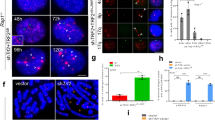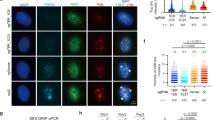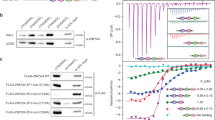Abstract
Double-strand breaks activate the ataxia telangiectasia mutated (ATM) kinase, which promotes the accumulation of DNA damage factors in the chromatin surrounding the break. The functional significance of the resulting DNA damage foci is poorly understood. Here we show that 53BP1 (also known as TRP53BP1), a component of DNA damage foci, changes the dynamic behaviour of chromatin to promote DNA repair. We used conditional deletion of the shelterin component TRF2 (also known as TERF2) from mouse cells (TRF2fl/-) to deprotect telomeres, which, like double-strand breaks, activate the ATM kinase, accumulate 53BP1 and are processed by non-homologous end joining (NHEJ)1,2. Deletion of TRF2 from 53BP1-deficient cells established that NHEJ of dysfunctional telomeres is strongly dependent on the binding of 53BP1 to damaged chromosome ends. To address the mechanism by which 53BP1 promotes NHEJ, we used time-lapse microscopy to measure telomere dynamics before and after their deprotection. Imaging showed that deprotected telomeres are more mobile and sample larger territories within the nucleus. This change in chromatin dynamics was dependent on 53BP1 and ATM but did not require a functional NHEJ pathway. We propose that the binding of 53BP1 near DNA breaks changes the dynamic behaviour of the local chromatin, thereby facilitating NHEJ repair reactions that involve distant sites, including joining of dysfunctional telomeres and AID (also known as AICDA)-induced breaks in immunoglobulin class-switch recombination.
This is a preview of subscription content, access via your institution
Access options
Subscribe to this journal
Receive 51 print issues and online access
$199.00 per year
only $3.90 per issue
Buy this article
- Purchase on Springer Link
- Instant access to full article PDF
Prices may be subject to local taxes which are calculated during checkout



Similar content being viewed by others
References
Celli, G. & de Lange, T. DNA processing not required for ATM-mediated telomere damage response after TRF2 deletion. Nature Cell Biol. 7, 712–718 (2005)
Celli, G. B., Lazzerini Denchi, E. & de Lange, T. Ku70 stimulates fusion of dysfunctional telomeres yet protects chromosome ends from homologous recombination. Nature Cell Biol. 8, 855–890 (2006)
Dimitrova, N. & de Lange, T. MDC1 accelerates non-homologous end-joining of dysfunctional telomeres. Genes Dev. 20, 3238–3243 (2006)
Lazzerini Denchi, E. & de Lange, T. Protection of telomeres through independent control of ATM and ATR by TRF2 and POT1. Nature 448, 1068–1071 (2007)
DiTullio, R. A. et al. 53BP1 functions in an ATM-dependent checkpoint pathway that is constitutively activated in human cancer. Nature Cell Biol. 4, 998–1002 (2002)
Wang, B., Matsuoka, S., Carpenter, P. B. & Elledge, S. J. 53BP1, a mediator of the DNA damage checkpoint. Science 298, 1435–1438 (2002)
Fernandez-Capetillo, O., Liebe, B., Scherthan, H. & Nussenzweig, A. H2AX regulates meiotic telomere clustering. J. Cell Biol. 163, 15–20 (2003)
Takai, H., Smogorzewska, A. & de Lange, T. DNA damage foci at dysfunctional telomeres. Curr. Biol. 13, 1549–1556 (2003)
Goldberg, M. et al. MDC1 is required for the intra-S-phase DNA damage checkpoint. Nature 421, 952–956 (2003)
Lou, Z., Minter-Dykhouse, K., Wu, X. & Chen, J. MDC1 is coupled to activated CHK2 in mammalian DNA damage response pathways. Nature 421, 957–961 (2003)
Stewart, G. S., Wang, B., Bignell, C. R., Taylor, A. M. & Elledge, S. J. MDC1 is a mediator of the mammalian DNA damage checkpoint. Nature 421, 961–966 (2003)
Ward, I. M., Minn, K., Jorda, K. G. & Chen, J. Accumulation of checkpoint protein 53BP1 at DNA breaks involves its binding to phosphorylated histone H2AX. J. Biol. Chem. 278, 19579–19582 (2003)
Bekker-Jensen, S., Lukas, C., Melander, F., Bartek, J. & Lukas, J. Dynamic assembly and sustained retention of 53BP1 at the sites of DNA damage are controlled by Mdc1/NFBD1. J. Cell Biol. 170, 201–211 (2005)
Botuyan, M. V. et al. Structural basis for the methylation state-specific recognition of histone H4–K20 by 53BP1 and Crb2 in DNA repair. Cell 127, 1361–1373 (2006)
Manis, J. P. et al. 53BP1 links DNA damage-response pathways to immunoglobulin heavy chain class-switch recombination. Nature Immunol. 5, 481–487 (2004)
Ward, I. M. et al. 53BP1 is required for class switch recombination. J. Cell Biol. 165, 459–464 (2004)
Reina-San-Martin, B., Chen, J., Nussenzweig, A. & Nussenzweig, M. C. Enhanced intra-switch region recombination during immunoglobulin class switch recombination in 53BP1-/- B cells. Eur. J. Immunol. 37, 235–239 (2007)
Lou, Z. et al. MDC1 maintains genomic stability by participating in the amplification of ATM-dependent DNA damage signals. Mol. Cell 21, 187–200 (2006)
Xie, A. et al. Distinct roles of chromatin-associated proteins MDC1 and 53BP1 in mammalian double-strand break repair. Mol. Cell 28, 1045–1057 (2007)
Ward, I. M., Minn, K., van Deursen, J. & Chen, J. p53 binding protein 53BP1 is required for DNA damage responses and tumor suppression in mice. Mol. Cell. Biol. 23, 2556–2563 (2003)
Konishi, A. & de Lange, T. Cell cycle control of telomere protection and NHEJ revealed by a ts mutation in the DNA-binding domain of TRF2. Genes Dev. 22, 1221–1230 (2008)
van Steensel, B. & de Lange, T. Control of telomere length by the human telomeric protein TRF1. Nature 385, 740–743 (1997)
Molenaar, C. et al. Visualizing telomere dynamics in living mammalian cells using PNA probes. EMBO J. 22, 6631–6641 (2003)
Kao, G. D. et al. Histone deacetylase 4 interacts with 53BP1 to mediate the DNA damage response. J. Cell Biol. 160, 1017–1027 (2003)
Abney, J. R., Cutler, B., Fillbach, M. L., Axelrod, D. & Scalettar, B. A. Chromatin dynamics in interphase nuclei and its implications for nuclear structure. J. Cell Biol. 137, 1459–1468 (1997)
Difilippantonio, S. et al. 53BP1 Facilitates long-range DNA end-joining during V(D)J recombination. Nature doi:10.1038/nature07476 (this issue).
Silver, D. P. & Livingston, D. M. Self-excising retroviral vectors encoding the Cre recombinase overcome Cre-mediated cellular toxicity. Mol. Cell 8, 233–243 (2001)
van Steensel, B., Smogorzewska, A. & de Lange, T. TRF2 protects human telomeres from end-to-end fusions. Cell 92, 401–413 (1998)
Lansdorp, P. M. et al. Heterogeneity in telomere length of human chromosomes. Hum. Mol. Genet. 5, 685–691 (1996)
Karlseder, J., Smogorzewska, A. & de Lange, T. Senescence induced by altered telomere state, not telomere loss. Science 295, 2446–2449 (2002)
Zhu, X. D. et al. Cell-cycle-regulated association of RAD50/MRE11/NBS1 with TRF2 and human telomeres. Nature Genet. 25, 347–352 (2000)
Sbalzarini, I. F. & Koumoutsakos, P. Feature point tracking and trajectory analysis for video imaging in cell biology. J. Struct. Biol. 151, 182–195 (2005)
Acknowledgements
We are grateful to J. Chen for his gift of 53BP1- and MDC1-deficient mice. We thank D. White for expert mouse husbandry. We thank the Bio-Imaging Facilities at Cold Spring Harbor Laboratory and at The Rockefeller University. J. Petrini is thanked for his gift of NBS1 antibody, A. Sfeir for providing the TRF1 antibody and A. Konishi for the BP1-2 construct. M. Dimitrov is thanked for mathematical advice on data analysis, and S. Jaramillo and Y. Fu for Matlab programming. Members of the de Lange laboratory are thanked for comments on the manuscript. This work was supported by a grant from the NIH (GM049046) and by the NIH Director’s Pioneer Award (OD000379) to T.d.L., and grants from the NIH to D.L.S. (EY18244 and GM42694). N.D. was supported by an HHMI pre-doctoral fellowship.
Author Contributions N.D. and T.d.L. planned and designed the experiments. N.D. performed all experiments. Y.-C.M.C. and D.L.S. provided assistance with the imaging experiments. N.D. and T.d.L. wrote the paper and made the figures.
Author information
Authors and Affiliations
Corresponding author
Supplementary information
Supplementary Information
This file contains Supplementary Methods, Supplementary Figures 1-11 with Legends and Supplementary Movie Legends 1-4 (PDF 5335 kb)
Supplementary Movie 1
Dynamic movement of dysfunctional telomeres is diminished in TRF2F/-53BP1-/- cells. Representative TRF2F/-53BP1+/- cells imaged 72 h after Cre infection. Z-stacks of EGFP-TRF1 [green] and mCherry-BP1-2 [red] signals were acquired every 30 sec over 20 min. Video constructed from deconvolved and projected frames. (MOV 105 kb)
Supplementary Movie 2
Dynamic movement of dysfunctional telomeres is diminished in TRF2F/-53BP1-/- cells: representative TRF2F/-53BP1-/- cells imaged 72 h after Cre infection. Z-stacks of EGFP-TRF1 [green] and mCherry-BP1-2 [red] signals were acquired every 30 sec over 20 min. Video constructed from deconvolved and projected frames. (MOV 78 kb)
Supplementary Movie 3
Potential fusion events in TRF2F/-53BP1+/- but not in TRF2F/-53BP1-/- cells. Videos from deconvolved and projected frames. The movie highlights telomeres undergoing a potential fusion reaction in a TRF2F/-53BP1+/- cell. (MOV 17 kb)
Supplementary Movie 4
Potential fusion events in TRF2F/-53BP1+/- but not in TRF2F/-53BP1-/- cells. Videos from deconvolved and projected frames. The movie highlights telomeres undergoing a potential fusion reaction in a group of closely apposed, but static telomeres in a TRF2F/-53BP1-/- cell. (MOV 12 kb)
Rights and permissions
About this article
Cite this article
Dimitrova, N., Chen, YC., Spector, D. et al. 53BP1 promotes non-homologous end joining of telomeres by increasing chromatin mobility. Nature 456, 524–528 (2008). https://doi.org/10.1038/nature07433
Received:
Accepted:
Published:
Issue Date:
DOI: https://doi.org/10.1038/nature07433
This article is cited by
-
DNA double-strand break end synapsis by DNA loop extrusion
Nature Communications (2023)
-
Homology directed telomere clustering, ultrabright telomere formation and nuclear envelope rupture in cells lacking TRF2B and RAP1
Nature Communications (2023)
-
Telomere attrition and inflammation: the chicken and the egg story
Egyptian Journal of Medical Human Genetics (2022)
-
PRMT1 and PRMT5: on the road of homologous recombination and non-homologous end joining
Genome Instability & Disease (2022)
-
Nuclear peripheral chromatin-lamin B1 interaction is required for global integrity of chromatin architecture and dynamics in human cells
Protein & Cell (2022)
Comments
By submitting a comment you agree to abide by our Terms and Community Guidelines. If you find something abusive or that does not comply with our terms or guidelines please flag it as inappropriate.



